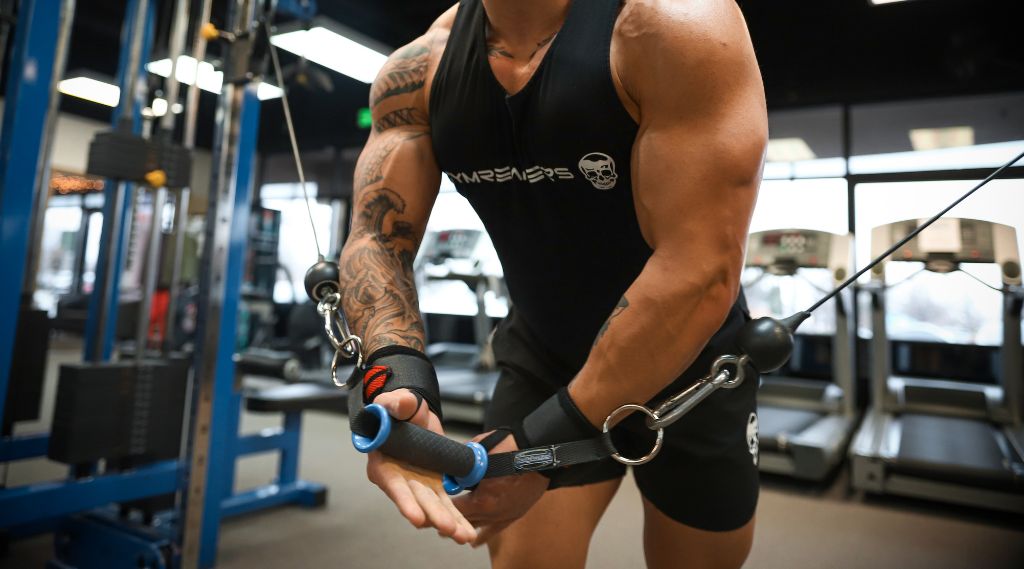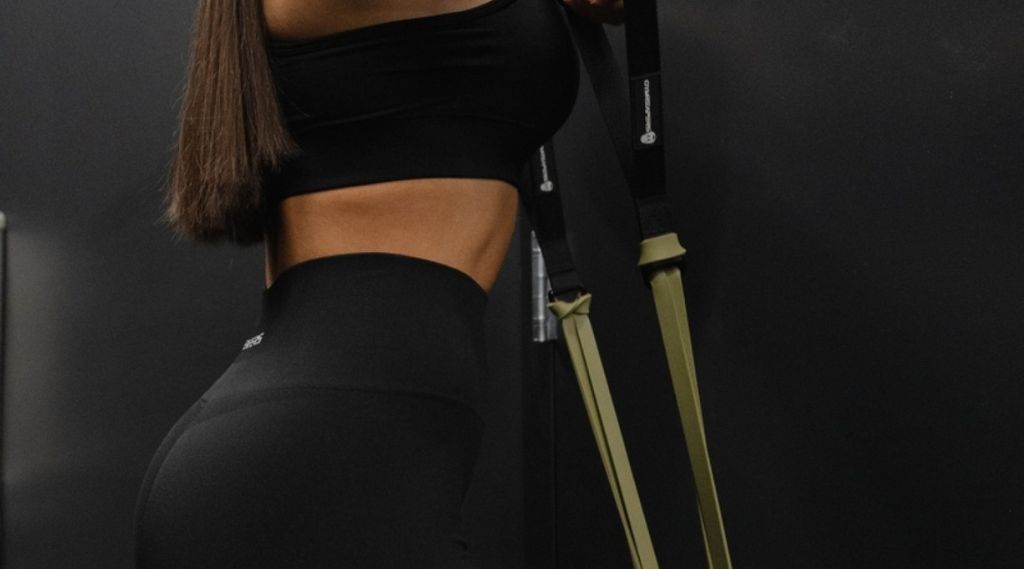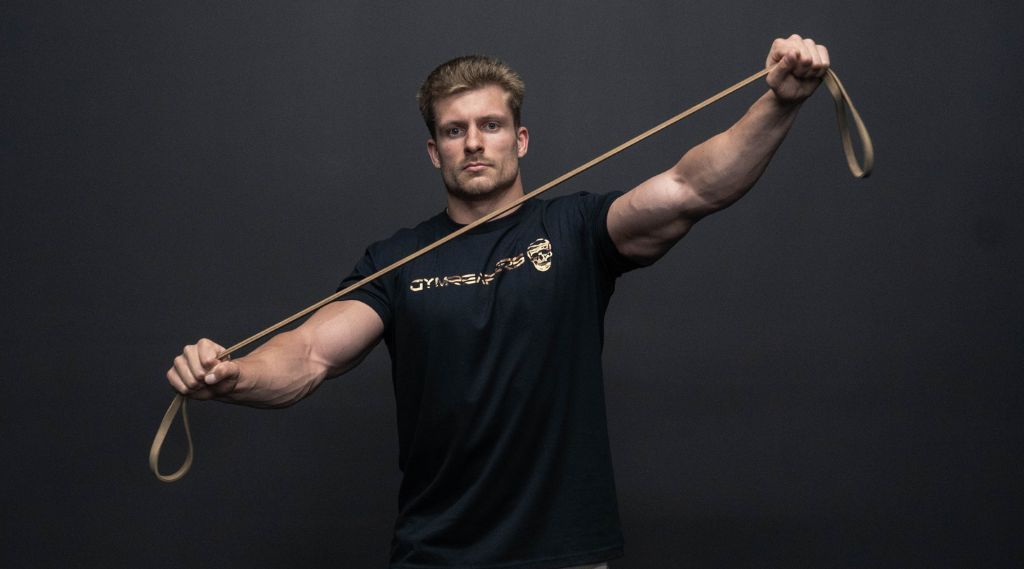Cable crossovers are a popular cable exercise for isolating the chest, but if you’re working out from home or while traveling, you may be wondering if you can replicate the movement with bands.
You can use bands to replicate the cable crossover when working out at home or while traveling by anchoring the band to a pole, squat rack, or door attachment at shoulder height. Using bands may increase muscle activation because they require your chest muscles to work more forcefully as they stretch.
To make the most of your cable crossovers with bands, I’ll teach you how to perform this exercise, highlight common mistakes, and provide tips on incorporating banded cable crossovers into your training routine.
Key Takeaways
- Cable crossovers with bands are an effective alternative to traditional cable machine exercises, allowing you to target and strengthen your chest muscles from the comfort of your own home.
-
Avoid common mistakes such as using momentum, maintaining poor body positioning, and limiting your range of motion. Gradually increase the intensity of the exercise by adjusting the resistance level of the bands.
- By utilizing 2-3 times per week frequency banded cable crossovers with proper form, appropriate resistance, and a consistent training schedule, you can develop a stronger and more defined chest.
Muscles Worked With Cable Crossovers

Cable crossovers primarily target the chest muscles, with some assistance from the shoulders and triceps. The contributing muscles are:
1) Pectoralis Major: This muscle is responsible for bringing your arms together horizontally, making it essential for movements like pushing and hugging.
2) Pectoralis Minor: This muscle's primary function is the stabilization of the shoulder joint and scapula. It also depresses, protracts, and internally rotates the scapula.
3) Anterior Deltoids (Front Shoulders): The anterior deltoid raises the arm forward at the shoulder joint.
4) Triceps: This muscle extends the elbow joint and keeps it locked into place to prevent it from flexing (bending)
These muscles work together to help you perform the cable crossover correctly, and are the muscles that benefit most from this particular exercise.
How To Do Cable Crossovers With Bands: Step-By-Step Guide
Performing cable crossovers with bands requires proper form and technique to maximize the benefits and minimize the risk of injury.
Follow these steps to ensure you perform the exercise correctly:
Step 1: Anchor the Bands
Start by anchoring two bands (one on each side) at approximately chest height. This can be done by tying the bands securely around a sturdy vertical structure such as a pole or door anchor.
Step 2: Position Yourself
Stand facing away from the anchor point, with one foot in front of the other for stability. Grasp the bands, one in each hand, keeping your arms extended out to the sides with a slight bend in the elbows. Your body should be in a slight forward lean, maintaining a neutral spine.
Step 3: Adjust the Resistance
Step forward to create tension in the bands. The further you step forward, the greater the resistance will be. Find a distance that challenges you but allows you to maintain proper form throughout the exercise.
Step 4: Perform the Movement
With your feet firmly planted and core engaged, exhale and bring your arms in a wide arc across your body, bringing your hands together in front of you (as if you were hugging someone). Focus on squeezing your chest.
Inhale as you return your arms to the starting position in a controlled manner.
Step 5: Repeat
Complete the desired number of repetitions for your workout. Aim for a smooth and controlled movement throughout the exercise, avoiding any jerking or bouncing motions.
Related Articles:
- Best Chest Exercises With Bands (+ Sample Workout)
- Chest Exercises Using Resistance Bands
Common Banded Cable Crossover Mistakes

To get the most out of your banded cable crossover exercise, it's crucial to avoid common mistakes that can compromise your form and reduce the effectiveness of the movement. Here are some common mistakes to watch out for:
Mistake #1: Using Too Much Momentum
One of the most common mistakes is relying on momentum to complete the movement instead of using the target muscles. This can be seen when individuals swing their arms forcefully, making the exercise more about speed rather than control.
The reliance on momentum often occurs when using too much resistance, requiring you to use as much momentum as you can to move the load rather than relying on your target muscles.
How To Fix: Pick a weight you can control and slow it down
Pick a resistance level that is challenging but doesn’t require you to lose your technique by swinging your body back and forth.
Additionally, focus on slowing down the movement by adding a tempo: Pull the band towards your midline, pause the rep for 1-2 seconds focusing on squeezing the pec muscle, then take 2-4 seconds to control the eccentric portion of the movement as you return to your starting point.
Mistake #2: Poor Body Positioning
Improper body positioning can lead to incorrect muscle activation and increase the strain on the joints. It's essential to maintain a slight forward lean, engage your core, and keep your spine neutral throughout the entire exercise.
If you have plateaued and are unable to increase the load without swinging, then you may need to reevaluate your technique and ensure you’re in the correct position.
How To Fix: Focus On Technique
Ensure you’re moving from a stable base; if your base isn’t stable then you will struggle to move against the resistance of the bands. To increase your stability, stagger your stance, engage your core, and squeeze your glutes.
This will help to ensure all of your stabilizing muscles are engaged and keep you locked into the right position.
Mistake #3: Insufficient Range of Motion
Many people perform cable crossovers with a limited range of motion, either by not bringing their arms together or not extending them fully during the return. This can limit muscle activation and diminish the exercise's effectiveness.
To build strength in all ranges of motion, you must train with a full range of motion. I’m sure you’ve heard the saying “If you don’t use it, you lose it” and that applies here as well. If you don’t use the full range of motion then you won’t build strength in those areas and, in extreme cases, you may even lose the ability to achieve that range of motion.
How to Fix: Focus on completing the entire repetition
When you’re using a band to perform cable crossovers, it can be difficult to judge the load that you need because the movement gets noticeably more difficult as you stretch the band. If the band resistance is too heavy, you won’t be able to squeeze your hands together in front of you at the end range of motion.
For this reason, it’s important to experiment with different band thicknesses to find one that is challenging but still allows you to complete the full range of motion.
To make sure the load is appropriate ensure that you can pull the band far enough to squeeze the pec muscle and that you can control the eccentric back to a deep stretch starting position.
Note: if you are experiencing pain that is limiting your range of motion, consult a physiotherapist.
Implementing Banded Cable Crossovers Into Your Training Routine

Now that you know how to perform banded cable crossovers and the mistakes to avoid, it’s time to learn how to incorporate them into your training routine.
Sets x Reps
Start with 2-4 sets of 10-20 repetitions, focusing on maintaining proper form throughout the exercise. As you progress and increase your strength and endurance, you can gradually increase the number of sets and repetitions.
Lower rep ranges (<10 reps) are not recommended as it will be hard to control the load through the range of motion and can lead to some of the common mistakes described above.
Load
The resistance level provided by the bands will vary depending on their thickness and the distance you step back from the anchor point.
Experiment with different band strengths to find a level of resistance that challenges you without compromising your form.
It's better to start with a lighter band and gradually progress to a heavier one as you get stronger; however, in this exercise, it is not uncommon to remain with lighter bands to ensure proper form.
If you cannot increase to a heavier band but are finding the one you’re currently using is getting to be too easy, then adjust the intensity by using a slower tempo.
Frequency
As a general guideline, aim to perform this exercise 1-3 times per week, allowing for adequate rest and recovery between sessions.
If your goal is maximum chest hypertrophy, then I recommend incorporating them 2-3 times per week at varied rep ranges and difficulties. If your goal is just to maintain the size and strength of your pecs, then include once per week along with other chest exercises.
Exercise Order
To target your chest muscles effectively, it's recommended to perform banded cable crossovers after your compound exercises like bench press or push-ups. This ensures that your chest muscles are pre-fatigued, allowing you to isolate and work them more effectively during cable crossovers.
Best Bands for Cable Crossovers
When it comes to selecting bands for cable crossovers, quality and durability are key factors. Gymreapers offer a range of high-quality resistance bands that are designed to withstand repetitive use.
They also feature a continuous loop design, making them easy to anchor and adjust for cable crossover exercises (as well as many other band exercises).

The Gymreapers Resistance Bands are available in various resistance levels, allowing you to choose the level of resistance that suits your current strength level and to progress over time.
Additionally, Gymreapers offers ankle straps, handles, and a door anchor. By pairing these with bands, it provides more flexibility to perform a wide range of exercises, including banded cable crossovers, from the comfort of your own home.














Leave a comment
All comments are moderated before being published.
This site is protected by hCaptcha and the hCaptcha Privacy Policy and Terms of Service apply.